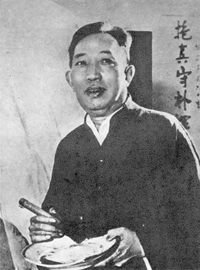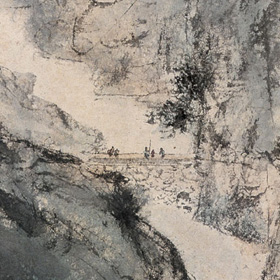Home >> Art >> Painting >> Masters >> Fu Baoshi Painting Gallery
Fu Baoshi (傅抱石, 1904-1965) was a Chinese painter from Xinyu (新余), Jiangxi Province. Credited with revolutionizing Chinese ink painting, Fu is perhaps the most original figure painter and landscapist of China's modern period, and one of the most important Chinese artists of the 20th century.
Fu Baoshi was eight years old in 1912 when China's last imperial dynasty was overthrown and the Chinese Republic was established. He subsequently witnessed the divisive warlord era of the 1920s, the Japanese invasion and occupation of eastern China from 1937 to 1945, and the Communist Revolution and establishment of the People's Republic of China in 1949. Over the last fifteen years of his life, his art reflected China's political transformation under Mao Zedong. Throughout his career, however, Fu remained one of China's greatest individualist masters.

In 1933, with help from Xu Beihong (徐悲鴻), Fu Baoshi went to Japan to study the History of Oriental Art in the Tokyo School of Fine Arts. After returning to China in 1935, Fu taught in the Art Department of Central University (now Nanjing University). Trained in both China and Japan at a time when arts education stressed the need for the modernization of indigenous traditions through the study of Western methods, Fu Baoshi developed a new style incorporating foreign styles and techniques, and began creating boldly individualistic and strongly nationalistic work. Noting that Chinese painting had evolved toward too great a dependency on monochromatic, calligraphic brushwork, Fu sought to revive earlier traditions of realistic description that made greater use of color and ink wash. His works of landscape painting employed skillful use of dots and inking methods, creating a new technique encompassing many varieties within traditional rules. He also stressed the need for an artist to be emotionally and physically present in his art. To achieve this end, Fu Baoshi often painted while inebriated. He also sought spontaneity through a spattered-ink method of painting—a kind of "action art" that parallels the working methods of some of the Abstract Expressionists.
Fu Baoshi had strong feelings towards the land of China. During his travel to many places, he recorded the splendors of the rivers and mountains, drawing inspiration from nature and becoming the representative landscape painter of his time.
Artworks by Fu Baoshi (view the entire painting gallery)
Click on the thumbnails to view large images.



